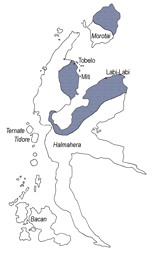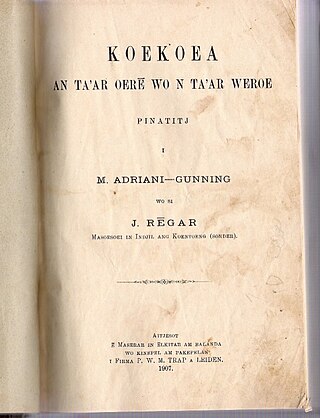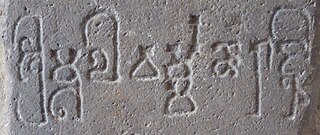
The Lingga Regency is a group of islands in Indonesia, located south of Singapore, along both sides of the equator, off the eastern coast of Riau Province on Sumatra island. They are south of the populated Riau Archipelago, known for the industrial island of Batam and the tourist-frequented island of Bintan, although the Lingga Islands themselves are rarely visited due to the infrequent local transportation. The equator goes through the northern tip of Lingga Island, the main island in the archipelago.
The Mentawai language is an Austronesian language, spoken by the Mentawai people of the Mentawai Islands, West Sumatra, Indonesia.

Tobelo is a North Halmahera language spoken on the eastern Indonesian island of Halmahera and on parts of several neighboring islands. The Tobelo-speaking heartland is in the six administrative districts of Tobelo, located on the western shore of Kao Bay and forming the central part of Halmahera Utara Regency. Other Tobelo-speaking areas are the five districts of Wasile on the southern and eastern shores of Kao Bay, and the northern half of Morotai Island. The district capital, also known as Tobelo, serves as a regional commercial and administrative center and is the largest settlement on Halmahera.

Bima is a city on the eastern coast of the island of Sumbawa in central Indonesia's province of West Nusa Tenggara. It is the largest city on the island of Sumbawa, with a population of 142,443 at the 2010 census and 155,140 at the 2020 census; the official estimate as at mid-2023 was 161,362. It is separate from the adjoining Regency of Bima which had a population of 535,530 according to the mid-2023 official estimates.
Sangirese, also known as Sangihé, Sangi, and Sangih, is an Austronesian language spoken on the islands linking northern Sulawesi, Indonesia, with Mindanao, Philippines by the Sangirese people.
Bijdragen tot de Taal-, Land- en Volkenkunde also known by the abbreviated name BKI, is a peer reviewed academic journal on Southeast Asia and Indonesia that was established in 1853 and was published by the Royal Netherlands Institute of Southeast Asian and Caribbean Studies. It was published as Bijdragen tot de taal-, land- en volkenkunde van Nederlandsch-Indië between 1853 and 1948. The journal focuses in particular on linguistics, anthropology, and history of Southeast Asia, and more specifically of Indonesia. It appears quarterly, running a total of roughly 600 pages annually. The editor-in-chief is Freek Colombijn.

Dalem Di Made was a king of Bali who may have reigned in the period 1623–1642. He belonged to a dynasty that claimed descent from the Majapahit Empire of Java, and kept residence in Gelgel, close to Bali's south coast.
The Etna expedition (1858) was an early policy-oriented exploration of the then virtually unknown south and north coast of Dutch New Guinea, that can also be regarded as the second Dutch scientific expedition to the main island of New Guinea since 1828.
Galela is the second most populous Papuan language spoken west of New Guinea, with some 80,000 speakers. Its dialects are Kadai (41,000), Morotai (24,000), Kadina (10,000), and Sopi (4,000). Its closest relative is the Loloda language.

The Manggarai language is the language of the Manggarai people from the western parts of the island of Flores, in East Nusa Tenggara Province, Indonesia.
Tabaru is a North Halmahera language of Indonesia.

Tontemboan is an Austronesian language, of northern Sulawesi, Indonesia. It is a Minahasan language, a sub-group of the Philippine languages.
Kendayan, or Salako (Selako), is a Malayic Dayak language of Borneo. The exact number of speakers remains unknown, but is estimated to be around 350,000.

Sri Mulavarman Nala Deva, was the king of the Kutai Martadipura Kingdom located in eastern Borneo around the year 400 CE. What little is known of him comes from the seven Yupa inscriptions found at a sanctuary in Kutai, East Kalimantan. He is known to have been generous to brahmins through the giving of gifts including thousands of cattle and large amounts of gold.
Termanu is a Central Malayo-Polynesian language of Roti Island, off Timor, Indonesia. Speakers of Korbafo and Bokai dialects are ethnically distinct.

Nicolaus Adriani was a Christian missionary from the Netherlands who did work in Indonesia. He studied linguistics of the East Indies at Leiden University, obtaining his PhD in 1893. He was sent by the Netherlands Bible Society. He worked as a linguist in Poso, Central Sulawesi.
Sultan Muda was a nominal sultan of Aceh in northern Sumatra. His brief tenure started a decade-long period of dynastic weakness and strife in the Aceh kingdom.
Hendrik Doijer Jzn was a Dutch politician, who first made a career in the administration on the Dutch Gold Coast and who became interim governor during the European leave of governor Henri Alexander Elias on 13 June 1864, upon the death of his interim predecessor Carel van Hien. He later became mayor of Zoeterwoude and Woerden.
Yap Goan Ho was a Chinese Indonesian translator, businessman, bookseller, and publisher based in Batavia, Dutch East Indies. In the 1880s and 1890s, he was one of the first Chinese Indonesians to own a printing press and the first to publish Chinese language novels in Malay language translations.
The Battle of Aceh was a 1528 military engagement between a lone Portuguese galley and an Acehnese armada near the coast of Aceh, located in present-day Indonesia. The Acehnese captured the Portuguese galley.











